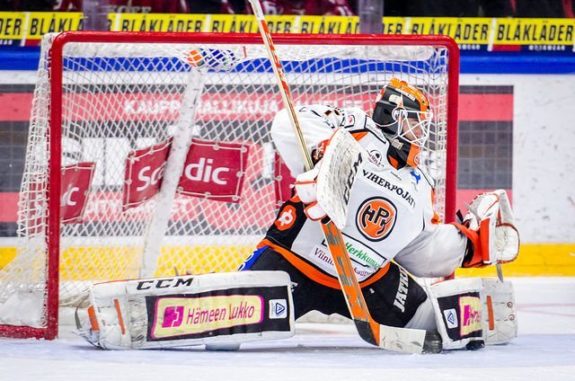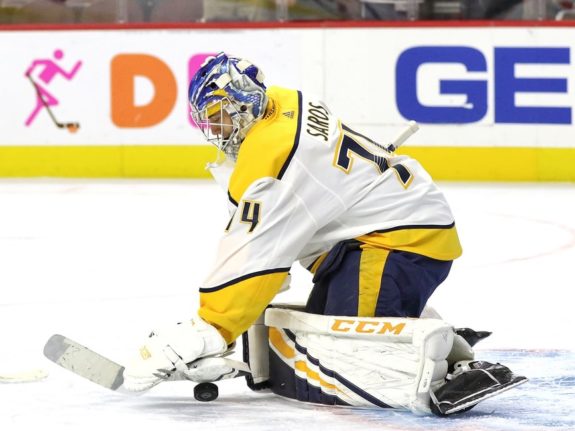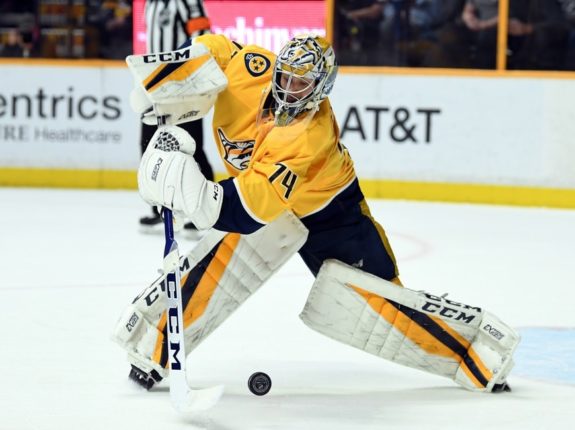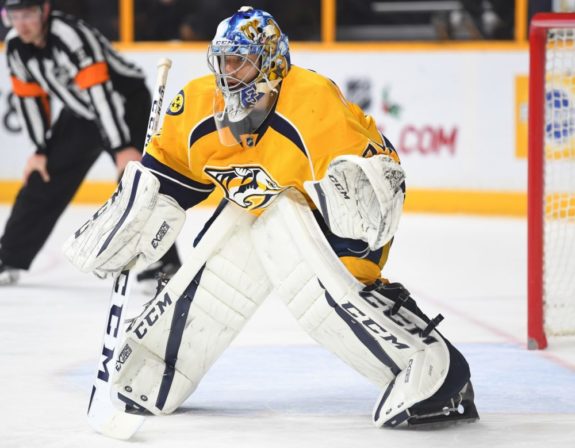Fans of the Nashville Predators probably haven’t spent a whole lot of time thinking about life after Pekka Rinne. It might be because they cannot bring themselves to even contemplate the Predators without the 6-foot-5, Vezina-winning goaltender.
Or maybe it’s because there hasn’t been any sign the day is even approaching, as the 36-year-old plays like he has been drinking from the same fountain of youth that New England Patriots star quarterback Tom Brady has. But, like it or not, the time will come where Rinne is not minding the net for the Predators.
As it currently stands, the amount of rest Rinne needs during a given season is increasing year after year. However, fear not Predators fans, the team is in more than capable hands. The Predators already have their post-Rinne solution and it comes in the form of 5-foot-11 goalie Jusse Saros, and he could be relied upon more than ever in this season.
Similar Origins
After being selected in the fourth round of the 2013 NHL Entry Draft, Saros played two seasons for Hämeenlinnan Pallokerho or HPK in the Finnish Elite League, formally known as SM-liiga, the same league that Rinne also played in before arriving in Nashville.

Now, most Predators fans know the story of Rinne being the backup to Niklas Backstrom while playing for Karpat.
With both goalies originating from the same country, once playing in the same league as one another and now playing for the same team, it’s hard not to make comparisons.
Due to his position on the goalie depth chart, Rinne only saw action in 25 games over three seasons for Karpat. Although, he only appeared in one game during his first official season, back in 2002-03. In 2003-04 Rinne suited up for 14 games, registering a 2.99 goals-against average (GAA) and a .897 save percentage. The very next season the native of Kempele, Finland was between the pipes for 10 games with much better numbers, ending the season with a 1.68 GAA and a .927 save percentage.
Related: Review Predators’ 2018-19 Season: Goaltending Edition
Comparing these numbers to Saros’ body of work in the same league shows that the “undersized” goalie is no slouch and could be the exception to the “ideal goalie size” rule.
Saros’ stats while playing for HPK cannot be ignored because they weren’t just good, they were scary good. During the 2013-14 season, the then 19-year-old played in 44 games, had a 1.76 GAA and a .923 save percentage. The season after, Saros played in 47 games, allowed an average of just 2.14 goals per game and finished with a save percentage of .929.

With talent such as Aleksander Barkov, Sami Vatanen, and Rasmus Ristolainen, to name a few, all coming from Finland’s top league, Saros’ resume is certainly valid when making an educated prediction when it comes to his future.
Making the Most of His Limited Opportunities
While serving as Rinne’s backup, Saros has seen his starts increase each of the past three seasons, from 19, to 26 and then his NHL career-high of 27 last season.
When Saros got his first real shot in the NHL, back in 2016-17, the Predators quickly took notice due to his unreal rookie numbers. The native Forssa, Finland finished the season with a 10-8-3 record, a GAA of 2.35 and save percentage of .923 – both the latter stats led the team.
It was always going to be difficult to maintain those impressive numbers and Saros has seen his stats dip in the seasons following his rookie year.
Statistically, last season was Saros’ worst season. However, that may not be indicative of his ability. Combining the fact that the young Finnish goaltender played the most games of his NHL career with the inconsistent starts, it’s reasonable for his numbers to diminish slightly. There were multiple stretches last season where Saros went up to 10 days between game action, which can make it hard for a goalie to find a rhythm, but such is the life of an NHL backup.

Saros also saw a lot of his starts come on the second half of back-to-backs, meaning he often had a tired team playing and defending in front of him. Out of Nashville’s 10 back-to-back games last season, Saros started the back half of those games seven times. During those seven games, Saros had a GAA of 2.43, so by season’s end, it’s easy to see how his stats could be inflated a little. However, even though Saros didn’t have a completely fresh team playing in front of him in those back-to-back games, he was still able to manage a .926 save percentage through that span.
Related: Rinne Extension Provides Predators with Plenty of Positives
There was a point last season where Nashville’s backup was promoted to the interim starter for unfortunate reasons. In just the Predators’ seventh contest, Rinne was injured and missed five games, allowing Saros to get consistent playing time and show what he can do when called upon to be the “go-to-guy.”
During those games, including the game the 24-year-old played in relief for the injured Rinne, Saros recorded a .922 save percentage and a 2.17 GAA. It’s a small sample size, but Saros definitely looks more comfortable when receiving frequent and consistent playing time. Who wouldn’t? Even seeing those types of numbers inflate a little would still put him in line to rival the numbers Rinne recorded during his Vezina-winning season.
The Predators’ Goalie Future Remains Bright
For as young as Saros is, he’s already shown he’s reliable and has definitely proven he can play in this league. Rinne appears to have gotten better with age and is the only barrier stopping Predators fans from watching Saros on a nightly basis. If Saros can harness his athletic ability to compensate for his size or “lack” of it, then it’s safe to assume the former member of the NHL All-Rookie Team will develop into an elite, perennial starter.

With Rinne turning 37 in November, most have speculated that the days of him starting 60 plus games, seen as recently as 2016-17, are over. Using the trend of Saros’ increased workload season-after-season, it’s logical to assume that we could see the goalie they call “Juice” play around 35 games this season and possibly receive more than 30 starts. Not only will that help Rinne remain fresh come playoff time, but it will also add some more insight to the Predators’ succession plan.
Expecting the former 99th overall pick to be as good as Rinne may be a lofty goal, which might even be setting the young goalie up for failure. After all, Rinne, with his many accolades, is consistently mentioned when discussing the best in the world. However, if Saros can even be a fraction of what Rinne has been for the Predators, then Nashville will be in very capable hands.